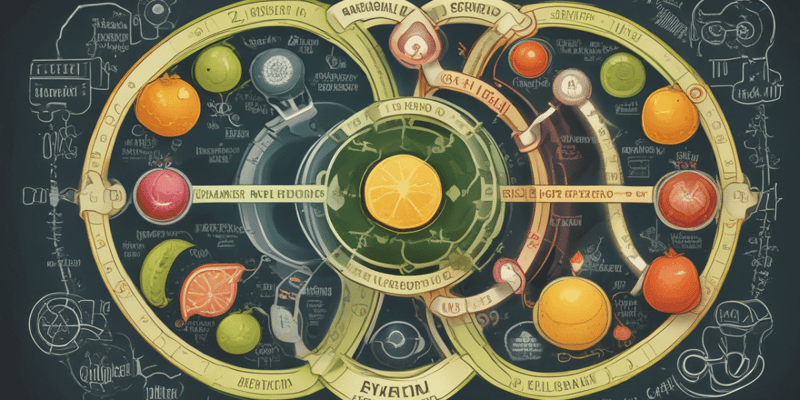30 Questions
Which of the following amino acids can never be used for gluconeogenesis?
Both Lysine and Leucine
What is the effect of increased intramitochondrial ATP concentration on Pyruvate Dehydrogenase Complex (PDH)?
Allosteric inhibition
What is the role of oxaloacetate in the citric acid cycle?
It plays a catalytic role and is regenerated at the end of the cycle
What is the effect of insulin on Pyruvate Dehydrogenase Complex (PDH)?
Covalent activation by dephosphorylation
What is the first step of the Citric Acid Cycle?
Reaction between acetyl-CoA and oxaloacetate
Where are the enzymes of the citric acid cycle located?
In the mitochondrial matrix or attached to the inner mitochondrial membrane
What is the prosthetic group of the succinate dehydrogenase enzyme?
FAD
Which of the following is a substrate for gluconeogenesis?
Lactate
What is the effect of glucagon on Pyruvate Dehydrogenase Complex (PDH)?
Covalent inhibition by phosphorylation
What happens when the concentration of citric acid cycle intermediates is lowered due to biosynthesis?
The concentrations are replenished by anaplerotic reactions
What is the most important anaplerotic reaction in mammalian liver?
The reversible carboxylation of pyruvate to form oxaloacetate
What is the reactant that is carboxylated to form oxaloacetate in the anaplerotic reaction catalyzed by pyruvate carboxylase?
Pyruvate
What is the final common pathway for the oxidation of carbohydrates, lipids, and proteins?
Citric acid cycle
Where does the enzyme Pyruvate Dehydrogenase Complex catalyze an irreversible reaction?
Mitochondrial matrix
What is the role of Pyruvate Carboxylase in gluconeogenesis?
To produce substrates for gluconeogenesis
What is the source of Acetyl-CoA production used in TCA or lipogenesis?
Pyruvate Dehydrogenase Complex
Where does the enzyme Lactate Dehydrogenase catalyze a reversible reaction?
Cytosol
What is the prosthetic group of Pyruvate Carboxylase?
Biotin
What is the primary function of the electron carriers NADH+H and FADH2 in cellular respiration?
To conserve energy from oxidations in the citric acid cycle
Which of the following is NOT a control mechanism of the citric acid cycle?
Covalent modifications
What is the significance of the citric acid cycle being an amphibolic process?
It is active in both anabolic and catabolic reactions
Which of the following enzymes is NOT regulated by covalent modifications?
Isocitrate dehydrogenase
What is the ultimate electron acceptor in the respiratory chain?
Oxygen
What is the outcome of the electron transfer process in the respiratory chain?
All of the above
What is the effect of acetyl-CoA accumulation on pyruvate carboxylase?
It acts as an allosteric activator
Where is lactate dehydrogenase located?
Cytosol
What is the prosthetic group of pyruvate carboxylase?
Biotin
What is the source of acetyl-CoA production in pyruvate dehydrogenase complex?
Pyruvate
What is the effect of acetyl-CoA accumulation on pyruvate dehydrogenase?
It acts as an inhibitor
What is the type of reaction catalyzed by pyruvate carboxylase?
Carboxylation
Study Notes
Citric Acid Cycle and Pyruvate Metabolism
- The citric acid cycle is the final common pathway for the oxidation of carbohydrates, lipids, and proteins, as glucose, fatty acids, and most amino acids are metabolized to acetyl-CoA or intermediates of the cycle.
- It plays a central role in gluconeogenesis, lipogenesis, and interconversion of amino acids (transamination and deamination).
- Pyruvate may diffuse into mitochondria and be oxidized by the citric acid cycle to generate energy.
Pyruvate Metabolism
- Pyruvate can be converted to lactate by lactate dehydrogenase in the cytosol, a reversible reaction.
- Pyruvate can be converted to acetyl-CoA by the pyruvate dehydrogenase complex in the mitochondria, an irreversible reaction.
- The pyruvate dehydrogenase complex is stimulated by high acetyl-CoA levels and produces substrates for gluconeogenesis.
Regulation of Pyruvate Dehydrogenase Complex
- Inhibitors: increased intramitochondrial ATP/ADP, acetyl-CoA/CoA, and NADH/NAD+ ratios, as well as glucagon, cause allosteric inhibition.
- Activators: increased intramitochondrial Ca2+, ADP, CoA, and NAD concentrations, as well as insulin, cause allosteric activation.
Citric Acid Cycle
- The cycle starts with the reaction between the acetyl moiety of acetyl-CoA and the four-carbon dicarboxylic acid oxaloacetate, forming a six-carbon tricarboxylic acid, citrate.
- In the subsequent reactions, two molecules of CO2 are released, and oxaloacetate is regenerated.
- The enzymes of the citric acid cycle are located in the mitochondrial matrix, either free or attached to the inner mitochondrial membrane.
- Succinate dehydrogenase enzyme (complex II of the ETC) connects the citric acid cycle to the ETC system.
Anaplerotic Reactions
- Anaplerotic reactions replenish the citric acid cycle intermediates when they are withdrawn for use in biosynthesis.
- The most important anaplerotic reaction in mammalian liver is the reversible carboxylation of pyruvate to form oxaloacetate, catalyzed by pyruvate carboxylase.
Control Mechanisms in Citric Acid Cycle
- Presence of substrate activates the enzymes responsible for the next step/reaction.
- Negative feed-back mechanism: products inhibit the enzymes responsible for their synthesis.
- Allosteric feed-back inhibition (no covalent modifications).
Regulator Enzymes of Citric Acid Cycle
- Citrate synthase, isocitrate dehydrogenase, and α-ketoglutarate dehydrogenase complex are not regulated by covalent modifications.
- Citric acid cycle is active in both fast and fed states (amphibolic process).
Understanding the citric acid cycle, its role in oxidation of carbohydrates, lipids, and proteins, and its connection to gluconeogenesis, lipogenesis, and amino acid interconversion.
Make Your Own Quizzes and Flashcards
Convert your notes into interactive study material.
Get started for free



